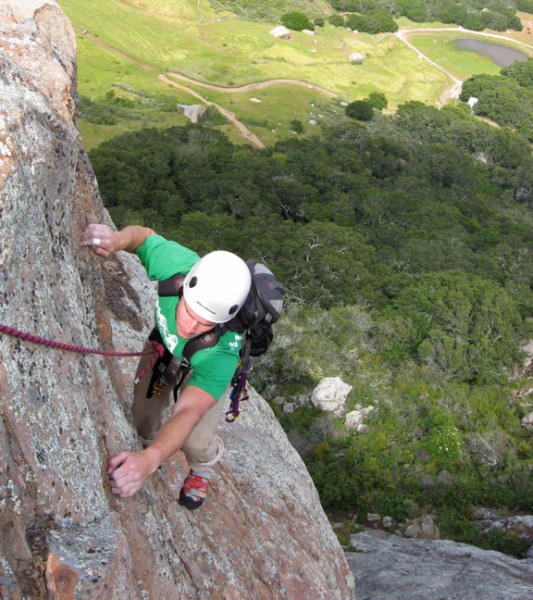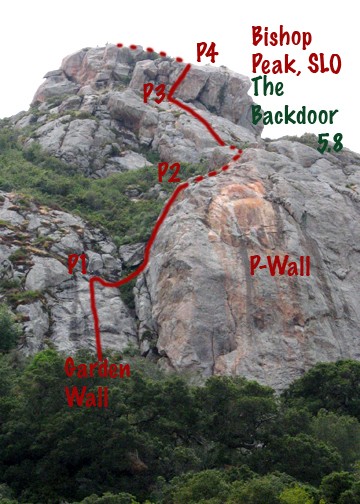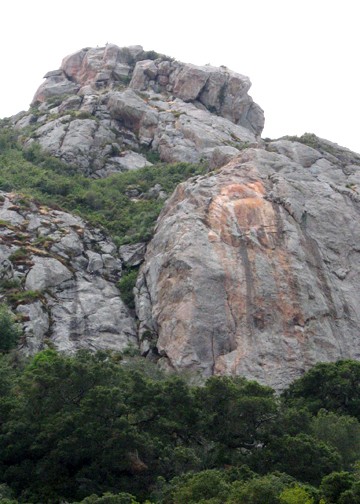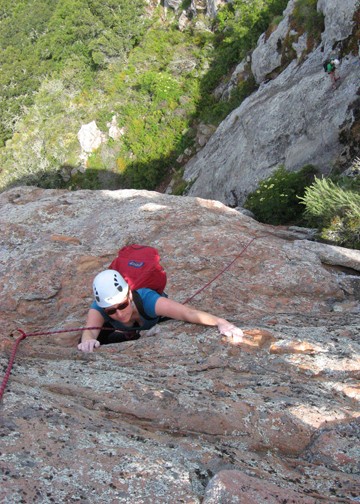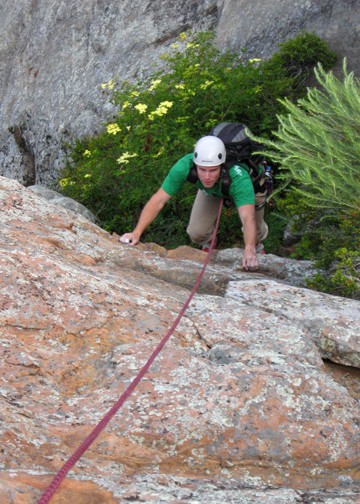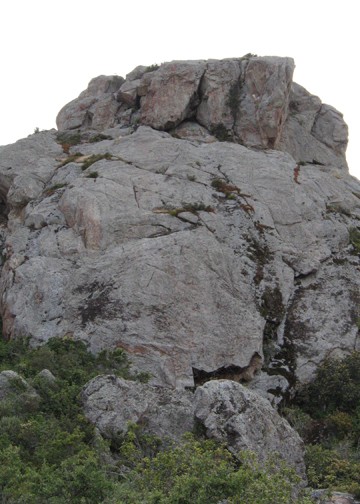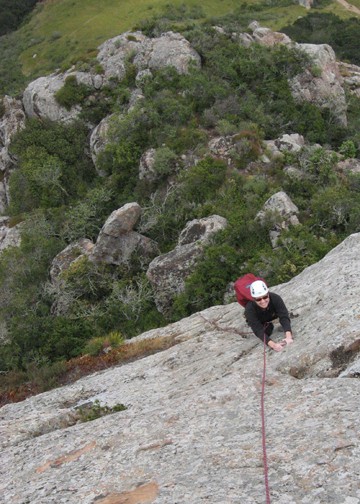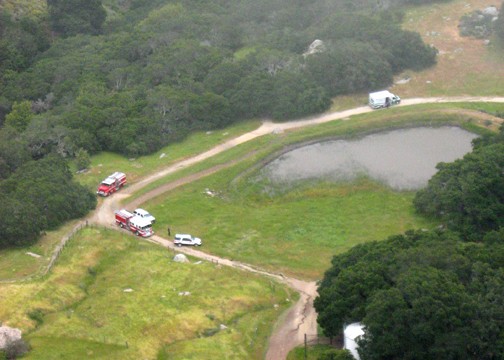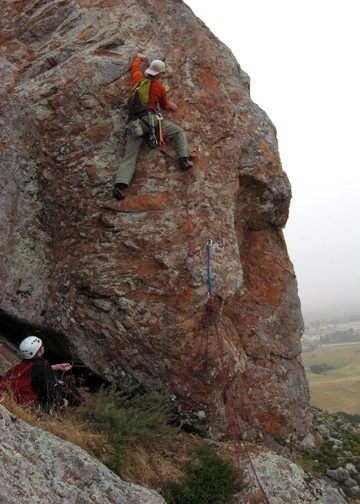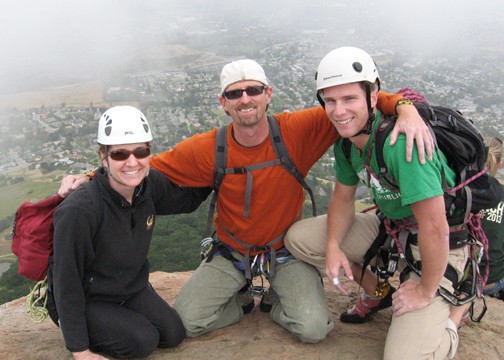Why hike when you can CLIMB!? Bishop Peak in San Luis Obispo, an iconic peak rising above the small college town and Hwy. 1 and Hwy. 101, begs to be summited. There are plenty of one and two pitch routes scattered around its flanks, but the best easy and most direct route up (with the least amount of bushwacking) would have to be "The Backdoor". Rated at 5.8 (with only a handful of crux moves) is an ideal romp for someone who wants to summit, but would rather climb to the top than hike.
Don't get me wrong, the hike up is a must do for any local or visitor, but come on... if you're a climber it's much better to employ the use of your hands and not just your feet. Plus... you still get to hike the trail back DOWN and take in the vistas... and smile at the hordes of locals and students hiking to the top.
I have done this route a lot, but this ascent was special. I have been teaching for 17 years and out of the blue one of my old students sent me an email asking to go climbing. The last time she had set foot in my classroom it was 1996 I believe, but during her time away she'd started climbing and was now back in her home town ready to sample the local rock. She'd never done a multi-picth climb, or used natural pro. So this would be an ideal adventure. My nephew and I just wanted some exercise to get ready for memorial weekend down south at Echo.
The Backdoor is fairly straight forward. You climb a route on Garden Wall, make a short traverse over to the left side of P-Wall, then up two short pitches just above P-Wall to the summit. There are many high quality one and two pitch routes on P-Wall as well, and many will also get you to the top two pitches and the summit. They range between 5.8-5.10 (harder sport routes on the right side of the wall) and require placing natural protection to augment the bolt protection. These routes went in ground up and are old school local classics. Tobin Sorenson's brother put in the classic "Out of Hangers" 5.10- Don't worry, it now has all the hangers. However, these routes might not be the right choice for a first multi-pitch adventure.
Our party of three roped up and started out around 2:30 pm. We traveled light, with 8 draws (you won't use more than 4 draws per pitch), .4" and .75" Camalots, and one 60m rope. The sky was blue but a few clouds lingered. My friend Don and his partner were just making the traverse over to the P-Wall when we started up, apparently they had the same idea in mind.
This is the main climbing area at Bishop Peak. The rock is dacite, usually covered in various colored lichens, and isn't that attractive to look at. But the rock is typically solid and quite hard. This is a step up from the soft central coast sandstone.
Claire on Garden Wall. The first pitch is rather simple, and goes up an undulating slab. You can pick from several crisscrossing lines, but most just climb straight up and clip 4 bolts en route to the anchors.
This is the Garden Wall anchor and view of SLO town. Bishop Peak makes for a great stop if you're traveling between SF area and LA, or in reverse.
The crux slab move is leaving garden wall and moving onto P-Wall's upper left side and onto Garden Party (5.7). Garden Party is relatively new, a route I thought about doing for 10 years but only put it in about 2 years ago with my friend Ken Klis. It climbs a previously ignored face that would otherwise be difficult to access were it not for the traverse.
This pitch is still cleaning up, but is fun and easy. The last moves are the most exciting as you exit through steep side-pulls.
This is the top half of the route. Like I said, the grey, lichen covered dacite isn't much to look at. But looks aren't always everything. About this time the coastal fog began to move in and temps dropped a good 10-15 degrees. I was glad I brought a long sleeve shirt.
Pitch 3 (Sunnyside 5.8) is arguably the best pitch of the four, the hardest, and is cleaning up nicely. John Knight put it in a couple years back and it was another key pitch to making it all come together. The start is steep with nice holds, and the pitch goes over a "roof" (.75") and then goes up a low angle slab (.4") to the anchors. The upper half kinda sucks, but the lower half makes up for it. Unfortunately I only have a picture of that upper half.
Due to the constant stream of traffic trekking up and down the peak, there are a lot of accidents, some fatal. Seems like once a weekend the CDF crew and fire dept. gets called out (all 5 trucks and often a helicopter). This time it was a twisted ankle. Last time it was a broken back. Keep an eye out on the trail, and especially on the tiny East Summit where crowds of tourists congregate (and for good reason - oh the view!). But watch your back. One bump and you could be sent hurtling off. It happens. More often than it should.
Here I am leading the last short pitch (There and Back Again 5.7) which ends at the base of the east summit blocks (the common summit, but not the "true" summit). Ken Klis and I put this pitch in and it was the last pitch to go in, and is very short, and loose, but it was the natural finish. You can move your belay up from the anchors of pitch 3 and clip the first bolt and have it double as a belay bolt. Or it is also possible to move from the top of pitch 3 anchors and do the 3rd class scramble to the base of pitch 4 and just go to the top of that pitch. We opted to move up our belay.
With a party of three, it took us over 2 hours. We had a great time and Claire busted out her first multi-pitch route. We jogged back down to the trail head and then grubbed at Chile Peppers (tradition). Their BBQ chicken burrito is what burritos should be, and I'd put it up against any burrito on the coast. Wash it down with some icy horchata and there you go! one damn fine day!
I was glad we made the most of Sunday because it is raining as I type this Monday morning (in mid May?!). El Nino strikes again. Hope you enjoyed this trip report! - Tom
